The Power of Focus in UX Design
In a world where digital products are increasingly complex, the ability to focus on what truly matters has become a competitive advantage. The Pareto Principle, also known as the 80/20 Rule, is one of the most practical and transformative ux laws designers can use to create maximum impact with minimal effort.
Named after Italian economist Vilfredo Pareto, this principle asserts that 80% of outcomes come from 20% of causes. In UX, this often means a small set of features, user flows, or design decisions will drive the majority of user engagement, satisfaction, or conversions.
Understanding and applying the Pareto Principle isn't just a time-saving technique it's a lens through which strategic, high-performance digital experiences are built.
What Is the Pareto Principle?
The Pareto Principle, first observed in economics, is now widely recognized across industries from software engineering to business management and user experience design.
In Simple Terms:
Roughly 80% of results come from 20% of efforts.
In the context of UX:
80% of traffic often comes from 20% of site pages.
80% of user issues stem from 20% of UI flaws.
80% of engagement happens through 20% of features.
While the exact ratio may vary, the principle’s core idea is prioritization identifying the “vital few” design elements that generate disproportionate results.
Why the Pareto Principle Matters in UX
Design teams are constantly balancing resources, user needs, and stakeholder expectations. Applying the Pareto Principle allows for smarter prioritization, guiding efforts toward high-impact outcomes.
Key Benefits:
Streamlines product development cycles
Eliminates design bloat and feature fatigue
Improves performance by focusing on user-critical paths
Boosts ROI through smarter resource allocation
Supports scalable, lean UX workflows
Rather than trying to improve everything at once, Pareto-driven design focuses on what matters most—what users actually use and value.
Where the Pareto Principle Shows Up in UX Design
Let’s break down real-world UX scenarios where the Pareto Principle can elevate design efficiency and user experience.
1. Homepage Optimization
Only a fraction of users scroll below the fold. By focusing on the top 20% of visible content—headlines, CTAs, navigation—you can improve conversions significantly without overhauling the entire page.
2. Feature Prioritization
Not every feature deserves equal investment. Use analytics to identify which 20% of your app’s features account for most user engagement. Prioritize those in usability testing and refinement.
3. Bug Fixing
User complaints often cluster around a small number of recurring issues. Addressing these “critical 20%” will reduce 80% of user frustration and support tickets.
4. Navigation Structure
Users typically rely on just a few top-level navigation items. Overdesigning secondary menus adds clutter without adding value. Pare down your IA to focus on the paths users actually take.
5. Content Strategy
From blog views to product pages, 20% of content often gets 80% of traffic. Audit your content performance to double down on what’s working and sunset the rest.
How to Apply the Pareto Principle in UX Workflows
✅ 1. Conduct Data-Driven UX Audits
Use analytics tools like Google Analytics, Hotjar, or Mixpanel to identify top-performing content, user flows, and features. Focus your UX improvements there.
✅ 2. Prioritize Usability Testing
Instead of testing every single interface, focus on critical user journeys—checkout flows, onboarding, account creation—where even small improvements can drive major gains.
✅ 3. Simplify the Interface
Remove or de-emphasize rarely used functions. Give more visibility to your power features that users love and use most.
✅ 4. Define MVPs Around the 20%
When launching a product or feature, identify the core 20% that delivers the highest value. This reduces time-to-market and helps test real impact before scaling.
✅ 5. Align Cross-Team Efforts
Product managers, designers, and developers can unify around a shared 80/20 roadmap—focusing resources on the features and fixes with the greatest impact.
How It Integrates with Other UX Laws
The Pareto Principle doesn’t exist in a vacuum. It strengthens and is reinforced by other ux laws:
Hick’s Law: Fewer, better-designed choices improve decision-making.
Fitts’s Law: Optimizing the usability of frequently used elements makes interfaces more efficient.
Tesler’s Law: Complexity should live in the backend. The Pareto Principle helps isolate what complexity actually matters to users.
Jakob’s Law: Users spend time on familiar patterns—likely the top 20%. Reinforcing these patterns supports user expectations.
Together, these laws shape intentional, focused design ecosystems.
Examples of the Pareto Principle in Action
Slack
Slack prioritizes messaging, channels, and notifications in its UI. While the platform offers a wide array of integrations and settings, 80% of user actions come from a handful of core interactions.
Most engagement on LinkedIn revolves around scrolling, liking, and commenting on the news feed. The platform refines these functions regularly while de-emphasizing less-used features.
Spotify
While Spotify has thousands of features, most users stick to playlists, search, and recommendations. Spotify continually optimizes this 20% to enhance retention and discovery.
Avoiding Misapplications of the Pareto Principle
The 80/20 rule is powerful but not infallible. Misusing it can lead to neglected user segments or underinvestment in innovation.
❌ Don’t Ignore the Remaining 80%
Secondary features and edge cases may matter deeply to niche users or stakeholders. Balance Pareto efficiency with inclusivity.
❌ Don’t Confuse Initial Impact with Long-Term Value
Initial usage data may favor short-term engagement features. Be mindful of strategic goals like accessibility, security, and future scalability.
❌ Don’t Oversimplify
The Pareto Principle is a guideline not a universal law. In some scenarios, the ratio might be 70/30 or 60/40. Always validate with research and context.
FAQs:
Q1: Is the 80/20 ratio always exact?
No. It’s a heuristic not a fixed rule. The real value lies in identifying disproportionate impact, not sticking to precise math.
Q2: Can the Pareto Principle be used in A/B testing?
Absolutely. Test variations of your top-performing features or flows to optimize that impactful 20%.
Q3: Does focusing on 20% limit innovation?
Not necessarily. It provides a foundation for sustainable design, freeing up resources for calculated experimentation.
Q4: How often should I review my 80/20 split?
Regularly. As user behavior shifts, what counts as the "critical 20%" will evolve. Perform UX audits quarterly or biannually.
Final Thoughts: Design Less, Impact More
In today’s UX landscape, designing everything for everyone is a fast path to mediocrity. The Pareto Principle helps designers focus energy where it truly counts on the features, content, and flows that create the most value.
As you apply the 80/20 rule across your design system, remember: your job isn’t to do more. It’s to do what matters most—beautifully, intentionally, and intelligently.







